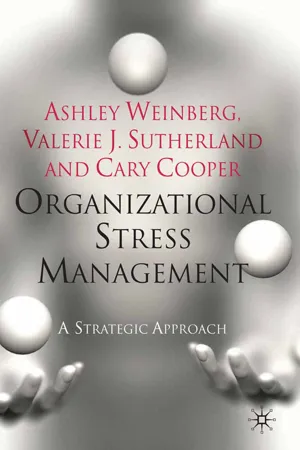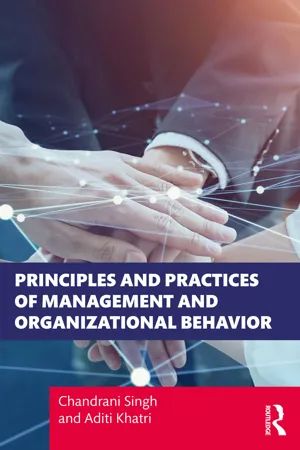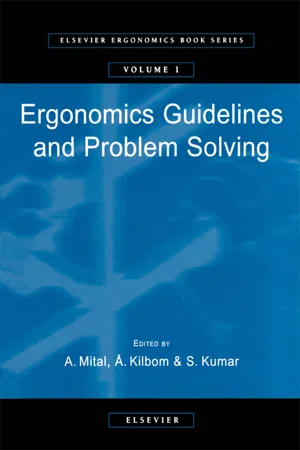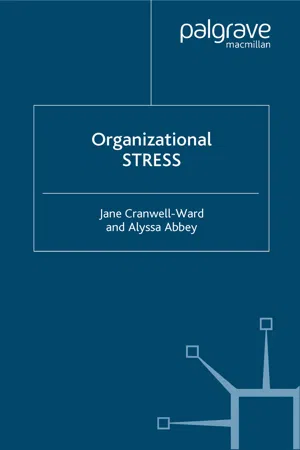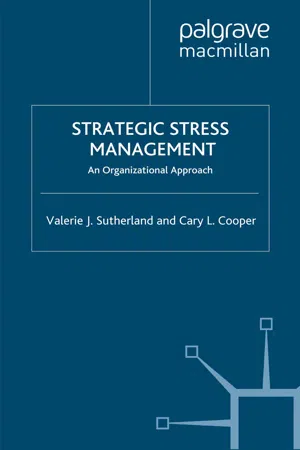Business
Stress Management in Organization
Stress management in organizations involves strategies and techniques implemented to help employees cope with and reduce work-related stress. This can include promoting work-life balance, providing resources for mental health support, and creating a positive work environment. Effective stress management can lead to improved employee well-being, increased productivity, and a healthier organizational culture.
Written by Perlego with AI-assistance
Related key terms
1 of 5
10 Key excerpts on "Stress Management in Organization"
- eBook - ePub
Organizational Stress Management
A Strategic Approach
- A. Weinberg, V. Sutherland, C. Cooper(Authors)
- 2015(Publication Date)
- Palgrave Macmillan(Publisher)
It is worth remembering that stress and pressure are an inevitable part of living and working, but distress is not! Our lives continue to become more complex. Like death and taxes, organization change will continue to be a feature of life in the twenty-first century and, thus, a potential source of stress. However, it is mismanaged stress that is damaging in its consequences. Both preventive and curative stress management strategies are essential in an organizational approach to stress control in the workplace, with education about psychological health, sound management skills and flexible working at their heart. Increasingly, evaluation studies indicate that prevention is more effective AND cheaper than trying to cure problems and victims of exposure to stress.Undoubtedly, stress management in the workplace must be the joint responsibility of both the organization and the individual. Both parties have a duty of care, and need to exercise this obligation in order to remain healthy and free from harm. Ultimately, the effective management of potential sources of stress is about being in control of the pressures in one’s life. While change will continue to exert a considerable force on our working lives, it must be acknowledged that some degree of pressure is inevitable and can be the spur to improved performance and motivation. Stress is a dynamic process, and this means that strategic stress management is not a one-off project. It must become an ongoing process within the organization based on awareness, analysis and action. To be successful, it must become part of day-to-day management and practice, and embedded within the culture of the organization. Ultimately, this is the only effective and cost-efficient strategy to avoid the unacceptable costs of distress in the workplace.We need to understand the nature of stress at work before we can eliminate or moderate it. A stress control program can be effective, if resources are targeted to specific problems and aimed at the elimination of the source of stress. Those organizations that recognize the high costs of mismanaged stress in the workplace, and seek to achieve enhanced levels of effectiveness and the well-being of their workforce, will adopt this integrated approach to stress management. It embraces both individual coping and organizational change to combat the problems associated with stress at work. If we can successfully coordinate both levels, we might be able to enact the words of Gandhi and “Be the change you wish to see in the world.” - eBook - PDF
- Michael A. Hitt, C. Chet Miller, Adrienne Colella, Maria Triana(Authors)
- 2017(Publication Date)
- Wiley(Publisher)
Organizational Stress Management Organizations can help reduce stress or help managers and associates deal more effectively with stress. To reduce stress, the following actions can be taken. These actions are consis- tent with high-involvement management: • Increase individuals’ autonomy and control. According to the demand–control model, increased control should help keep experienced stress to manageable levels. • Ensure that individuals are compensated properly. According to the effort–rewards imbalance model, proper compensation should help to keep experienced stress to manageable levels. • Maintain job demands/requirements at healthy levels. • Ensure that associates have adequate skills to keep up to date with technical changes in the workplace. • Increase associate involvement in important decision making. • Improve physical working conditions. For example, use ergonomically sound equip- ment and tools. • Provide for job security and career development. Provide educational opportunities so associates can continue to improve their skill sets. Use job redesign and job rotation to expand associates’ skill sets. • Provide healthy work schedules. Avoid constant shifting of schedules. Allow for flextime or other alternative work schedules. • Improve communication to help avoid uncertainty and ambiguity. In addition to actions taken to reduce stress, organizations can help associates and man- agers cope with stress and its effects. Specifically, they can encourage some managers to be “toxin handlers,” and they can implement wellness programs. These are discussed next. Toxin handlers, a term coined by renowned educator and consultant Peter Frost, are people who take it upon themselves to handle the pain and stressors that are part of everyday life in organizations. 105 Frost argues that toxin handlers are necessary for organi- zations to be successful, even though their contributions are often overlooked. - eBook - ePub
Job Stress
From Theory to Suggestion
- John M Ivancevich, Daniel C Ganster(Authors)
- 2014(Publication Date)
- Routledge(Publisher)
Perhaps the most glaring impression we received from the review was the lack of evaluative research in this domain. Most of the strategies reviewed were based on professional opinions and related research. Very few have been evaluated directly with any sort of scientific rigor. In spite of this weak empirical base, many personal and organizational strategies for handling stress have been espoused. Although some of these strategies seem to glow with an aura of face validity, there remains the extremely difficult task of validating their effectiveness; until this is done, practitioners have little more than their common sense and visceral instincts to rely on as they attempt to develop badly needed preventive and creative stress management programs.(Newman & Beehr, 1979, p. 35)Since this quote was made in 1979 there has been very few research reported investigations of what can be designated as an organizational level stress management intervention program; that is, a program that has as its purpose the reduction or minimization of stress that focuses primarily on organizationally specific stressors. The present paper will examine organizational level stress management intervention in terms of available research and will then provide some suggested strategies for filling the empirical gap that so obviously exists.Stress Management Programs
What is an organizational level stress management intervention? Answering this question is the first problem we encounter in examining the effectiveness of programs. There is not only confusion surrounding the topic of "stress" and what we mean by the word, but there is also uncertainty about what should be classified as a "stress management intervention" in an organization. In this paper we have elected to not add to the confusion and to simply state that organizational level stress management intervention programs are any effort initiated by the management of an organization that focuses on job specific stressors (e.g., intrinsic to the job, structure) intended to reduce any assumed negative outcomes and consequences associated with stress. This definition includes programs that attempt to remove stressors from the work environment and those that attempt to match an individual's needs, goals, aspirations, skills, and abilities with job tasks and environment. - Chandrani Singh, Aditi Khatri(Authors)
- 2024(Publication Date)
- Routledge India(Publisher)
- Including stress management training sessions for all. The topics included stress definitions, stress points, targets aimed at reducing stress cases, the company’s legal obligation to health and safety legislation’s, and so on.
- Advising managers to initiate effective time management across teams, ensure healthy working patterns through increased communication and collaboration, initiate smooth transitions among the members of the team, and promote proper exercise, diet, and sleeping rules for all.
- Weekly visits by stress management consultants for expert suggestions and ideas on how to de-stress.
- Establishing a gymnasium and indoor play area for employees to stay fit.
- Proper task allocation to avoid work overload.
After taking these steps, it was found that within the span of a quarter, employees’ stress came down from 37 percent to 17 percent within the organization. The productivity rose from 42 percent to 58 percent and overall employee satisfaction increased to a whopping 79 percent. The top- and middle-level management was satisfied to have combated stress for a long time.18.1 Introduction
The term ‘stress’ has been derived from the Latin word stringer, which means to draw tight. It is a multifarious phenomenon. It is an emotion that arises when we face a particular situation. It may differ from individual to individual. In other words, a situation or circumstance might be a challenge for one individual, whereas for the other, it might be a stressor. This basically depends on the experience, personality, and the environment in which the individual operates. The ever-changing situations that an individual has to face cause stress. Thus, today, stress has become a part of our daily life, which has a huge impact on all the activities we perform. Hence, managing stress effectively is essential.18.2 Definitions
Stress is a feeling experienced when a person thinks that the demands exceeds the personal and social resources the individual is able to mobilize.—Richard S. Lazarus- Rabi S. Bhagat, James Segovis, Terry Nelson(Authors)
- 2016(Publication Date)
- Routledge(Publisher)
The focus of much of stress literature has been on symptom management, whether psychological and physiological (Lazarus & Folkman, 1984). How we manage our somatic health is critical. Otherwise, we will enter a negative spi-raling loop with our health symptoms compounding the various situational problems we need to solve. Our struggles with specific stress illnesses, such as stomach ulcers or depression, will become an added burden as we confront the daily source of the stressors. As we lose critical health resources, we will struggle even more with our depleted energy base or attempt to conserve what we have through passive strategies (Hobfoll, 1989; Hobfoll & Shirom, 1993). Within organizational research, there is a dominance of secondary and tertiary symptom management interventions. Fortunately, a number of these interventions gives us a wide body of effective strategies to reduce and treat any harmful somatic and psychological effects, if only in a reactive fashion. Organizational wellness programs, though, have evolved as a secondary stress management intervention to be a valuable tool in this process (Bennett, Cook, & Pelletier, 2011). Of course as discussed earlier in this chapter, this depends on how seriously companies intend to integrate these practices into the fabric of their management systems to create a healthy workplace to assist workers’ symptom management.This transformative model of stress management then offers a comprehensive and dynamic framework to explain why specific interventions are more successful than others. The more a stress management strategy addresses the issues of mastery, meaning, social-community connections, positive self-regard, and symptom management, the more likely it will promote psychological and physical well-being. In essence, as each component of the model increases in use, it then builds an overall sense of coherence for individuals where their lives can be seen as comprehensible, manageable, and meaningful (Antonovsky, 1987, 1993). There exists a pervasive feeling that your life is predictable and you have the necessary resources to engage your environments’ demands as challenges. At a macrolevel, this model also explains why many of the primary and sec-ondary interventions developed by organizations have achieved mixed results. In many situations, management’s leadership has not fully enabled workers to have the ability to master their situations, create meaningful work, or build a sense of community. It is then left to the employees to cope with this process with the numerous barriers placed in their way. Tertiary interventions remain then the only option at this point to treat the dysfunctional consequences of the distress. Fortunately, this negative scenario does not necessarily have to occur as frequently as it does. Fortune magazine’s Top 100 Companies To Work For issue each year clearly illustrates along with the winners of such awards as the Corporate Health and Productivity Management Awards- eBook - ePub
- A. Mital, Å. Kilbom, S. Kumar(Authors)
- 2000(Publication Date)
- Elsevier Science(Publisher)
For example, Howard et al. (1975) determined that the most successful strategies for coping with stress used by managers were changing to a non-work activity, building better resistance through regular sleep and good health habits, separating work and non-work life, talking with coworkers and engaging in physical exercise. Many of these techniques have been associated with lower stress levels in intervention studies, for example Fremont and Craighead (1987) found that exercise programmes helped to control the level of emotional stress. It should be pointed out, however, that the behaviours shown to be used by individuals who cope successfully with stress tend to be emotion-based strategies which have little effect on min-imising actual exposure to work stressors (Pearlin and Schooler, 1978). Problem-based strategies are needed to cope with the source of stress. This suggests that the strategies that people spontaneously generate to cope do not tackle the real causes of their stress problems, but only help to tolerate them. It can be argued, therefore, that workers need training to help deal with work stressors, but that this training must emphasise problem-based strategies, and it must be linked to other organisational strategies to reduce their exposure to stressors. Implementing individual interventions: Individual stress management in organisations normally takes one or both of two forms, training programmes conducted usually by a consultant expert and Employee Assistance Programmes. The individual stress management strategies described in the preceding discussion would typically be conducted as part of a training programme. Techniques like muscle relaxation, meditation and time management are taught in workplaces often in a general health promotion context rather than in response to a known problem - eBook - PDF
- J. Cranwell-Ward, A. Abbey(Authors)
- 2005(Publication Date)
- Palgrave Macmillan(Publisher)
Goal setting for individuals becomes critically integrated with the vision, strategy, and objectives of the organization, and should be monitored and reviewed, as outlined in Figure 12.2. As part of managing stress levels effectively, the organization’s vision must be identified and clearly articulated to everyone in the organization. The strategy flows from the vision, followed by objective setting and planning – objectives for each part of the organization are set and these are then trans- 128 PART III STRESS: AN ORGANIZATIONAL PERSPECTIVE lated into individual targets. Great care must be taken to ensure these targets are stretching, achievable, and clearly stated and specific. Following this stage, managers must ensure their people have the right skills and abilities to achieve their goals, arranging appropriate development, including coaching, if necessary. Managing performance is a further ingredient in creating a positive stress environment. It requires managers to review progress regularly, reward good performance, and take appropriate action when people fail to achieve targets. The 21st century has brought with it unprecedented levels of change: change gives rise to ambiguity and uncertainty and, in turn, increases stress levels. Managers must ensure that they communicate well with staff and give them adequate support to help to keep stress at optimum levels. Summary Stress can be positive and help people to achieve exceptional performance, provided it is appropriately managed. This means regular monitoring of stress levels to check that people have not reached exhaustion level (hyper-stress). Lessons from the Yerkes-Dodson Law demonstrate that too little pressure can be as bad for performance as too much pressure. Without the flow of epinephrine (adrenalin), people can become apathetic, bored or frustrated and, therefore, stressed. - eBook - ePub
- Jack Dunham(Author)
- 2003(Publication Date)
- Routledge(Publisher)
Chapter 10Stress management
There is growing concern among teachers about the increasing mental, physical and emotional costs of stress at work. Their concern is reflected in the number of objectives related to stress which teachers want to achieve on my management courses, such as learning:- how to avoid stress;
- coping strategies;
- how to help people smile and stay sane;
- how to improve the quality of life within school;
- how to reassure colleagues;
- survival skills;
- how to provide active support for colleagues.
This chapter uses these objectives as its targets and presents a framework to achieve them. Teachers have found it helpful in preparing, developing, practising and monitoring the beneficial effects of personal and whole school stress management programmes and policies. This framework has six parts:- accepting the existence of stress in themselves and their colleagues caused by work pressures;
- learning to understand what stress is;
- beginning to tackle the problem by identifying the work pressures which are sources of stress;
- recognising the signs of stress which are the reaction to these negative pressures;
- identifying the coping strategies and resources which teachers use to reduce work pressures and the signs of stress;
- developing personal and whole-school stress management programmes and policies.
ACCEPTANCE OF STRESS
A primary teacher emphasised the importance of this first step in a stress management programme:A secondary teacher wrote of the stigma which is still associated with stress:I have learned not to be too proud to ask for help. I now know that acknowledging anxiety to yourself and expressing it to the right people is the first step in relieving it. Having had a complete breakdown I would plead with anyone to acknowledge stress long before it gets to that stage.It seems to me that the most important aspect of coping with stress must be the recognition by an individual that stress is part of his/her problem. One’s colleagues in the staffroom exhibit many symptoms which I would now associate with stress. I think that many of the sufferers would deny that they were prone to such weaknesses. - eBook - PDF
Industrial/Organizational Psychology
An Applied Approach
- Michael Aamodt(Author)
- 2015(Publication Date)
- Cengage Learning EMEA(Publisher)
For example, free voluntary counseling is made available by many organizations to all employees exhibiting emotional or discipline problems and particularly to those who have been terminated or laid off. Health-Care Costs One other organizational, as well as personal, consequence of stress is an increase in health insurance premiums. Because of the high use of medical facilities and options by others suffering from illnesses caused by stress, organizations that at one time paid the full cost for health insurance benefits are passing the increases on to the employ-ees. This additional financial burden to some employees can be a new source of stress! The answer is to reduce the number of ailments causing stress, thereby decreasing the need to seek medical attention. 564 CHAPTER 15 Copyright 2016 Cengage Learning. All Rights Reserved. May not be copied, scanned, or duplicated, in whole or in part. Due to electronic rights, some third party content may be suppressed from the eBook and/or eChapter(s). Editorial review has deemed that any suppressed content does not materially affect the overall learning experience. Cengage Learning reserves the right to remove additional content at any time if subsequent rights restrictions require it. Managing Stress Managing stress, or better yet, changing your behavior to healthfully respond to stress, should occur before, during, and after stress (Tyler, 2003a). Managing stress before it happens means incorporating daily practices (e.g., exercise) that will prepare your mind and body to handle the effects of stress. During stress you should continue with your prestress management techniques (such as reducing caffeine), as well as incorporate some others. Finally, after the stressor is eliminated (if that’s even possi-ble!), continue to proactively manage your stress. In addition, there are some other things you should consider. Let’s examine some techniques for before, during, and after stress. - eBook - PDF
Strategic Stress Management
An Organizational Approach
- V. Sutherland, C. Cooper(Authors)
- 2000(Publication Date)
- Palgrave Macmillan(Publisher)
Therefore, it is suggested that the effects of exposure to stress could be minimized by the use of techniques aimed at improving stress coping processes by the individual. Therefore, secondary prevention is Options for the Mangement of Stress ill the Workplace 189 concerned with the prompt detection and management of potentially deleterious conditions by increasing self-awareness and improving stress management skills. Whilst these strategies are usually conceptualized as 'individual' level stress management options, they also embrace the view of individual employees working within a team or work-group. Newman and Beehr (1979) grouped these strategies into four categories aimed at: I. Psychological condition • planning ahead, managing one's life, • self awareness, • realistic aspirations. 2. Physiological or physical conditions • diet, • sleep, • exercise, • relaxation and meditation, • anger management. 3. Changing behaviour • taking time off for leisure and holidays, • changing celtain aspects of behaviour that are stress inducing, • building social support networks at home and work, • being more assertive. 4. Changing the environment • changing to a less demanding job, • changing to a less demanding organization. It is commonplace for organizations to help individuals to either minimize the effects of exposure to stress, or to learn techniques to cope more effectively with stress. We classify these under two separate headings, namely 'skills training options' and 'healthy lifestyle education and management'. Skills training The term 'skills traInIng options' refers to the fact that the stress management activity is in the provision of training per se. After training, individuals or work groups are required to put their new skills into practice by using them to deal with potentially stressful situations.
Index pages curate the most relevant extracts from our library of academic textbooks. They’ve been created using an in-house natural language model (NLM), each adding context and meaning to key research topics.
